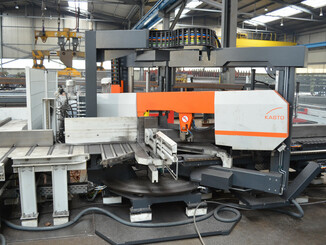
Digitalization and networking are rapidly advancing in metal processing – also in storage and sawing technology. Manual and mutually isolated processes are increasingly giving way to a continuously controlled, intelligent material flow in which all the components involved communicate autonomously with each other. At Kasto, this topic is no longer a dream of the future: The saw and storage technology manufacturer already has numerous solutions in its portfolio to make metal processing more efficient, flexible and cost-effective in the age of Industry 4.0.
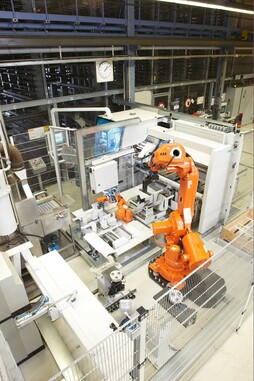
© Kasto
Industry 4.0 has now arrived across the board in modern metal processing. Machines, systems, goods and load carriers are digitally networked and can communicate with each other. Intelligent sensor systems provide current status information in real time. All process-relevant data is recorded and analyzed. This enables users to optimize their entire value chain in a decentralized, autonomous and demand-oriented manner. The path from the raw material to the finished product is thus faster, more flexible, more resource-efficient and more cost-effective – this helps metalworking companies from all sectors to meet the increasing demands of international competition.
This already starts with storage: instead of the previously widespread floor or cantilever storage, metal processing companies are increasingly using fully automatic long goods storage systems. The software-controlled systems convince with a significantly higher storage density, fast access times and maximum inventory transparency. They can also be used to implement various storage strategies that are perfectly adapted to the needs of the respective company: Among other things, users can store single bars, whole or opened bundles manually or automatically, as well as transfer between different storage areas – depending on which process is most efficient overall. This saves a lot of time and money in the long run.
The sawing technology – often the first processing station after removal from storage – is also increasingly organized without a operator. Sawing machines can be seamlessly connected to the raw materials warehouse with manipulators and conveyor technology and supplied with the required materials via this. The sawing process itself also runs autonomously if the machine is suitably equipped. This results in highly integrated systems that are seamlessly integrated into a continuous material flow – the intelligent factory.
Fully automatic from raw material to finished part
A leading provider of Industry 4.0 solutions for metal processing is Kasto Maschinenbau. The company implements combined storage-saw-robot systems for its customers, in which all storage, handling, sawing, marking, palletizing and bundling processes run fully automatically, from the storage of the raw material to the picking of the sections. Smooth communication is particularly important here: all the components involved must, to put it simply, speak the same language. This is made possible by integrated control systems and suitable interfaces. With Kastologic, for example, Kasto offers a modular Warehouse Management System (WMS) that is specially adapted to the requirements of long goods and sheet metal storage. It maps all processes between goods receipt and dispatch clearly and transparently and ensures efficient control of the entire material flow – including the warehouse, connected conveyor technology and processing machines with the associated material handling.
The software optimizes the processes in and around the warehouse, making intralogistics faster, more reliable and more efficient. For example, it makes the travel paths of stacker cranes more efficient by avoiding empty runs and placing items that are needed more frequently closer to storage and retrieval stations than those that are demanded less frequently. The management of orders, batches, remaining parts and gates, a permanent inventory as well as the possibility to flexibly apply different in-out strategies and picking principles are further helpful functions of Kastologic. The comprehensive statistics and analysis tools monitor both the utilization of the entire system and that of individual components. In this way, the potential of intralogistics can be fully exploited: superfluous routes or unnecessary waiting times are avoided, possible changes can be simulated in advance and tried out without risk.
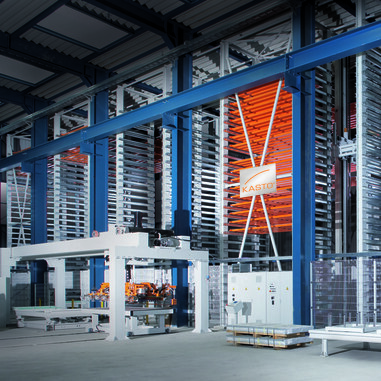
© Kasto
The right interface for every system
The WMS Kastologic, but also individual machine controls from Kasto, can be effortlessly connected to a higher-level host system in the company via customized interfaces – from SAP to Infor or Microsoft Dynamics to customer-specific software solutions. The resulting uniform communication structure significantly increases transparency and efficiency. Orders can be controlled in a convenient and user-friendly way, and the data collected and recorded in the warehouses and sawing machines can be used and analyzed across the board. This enables, for example, a continuous tracing of certain goods and workpieces, an even utilization of the machine park with short non-productive times, a better quality control or a better planning of maintenance measures. Residual piece lengths and stock levels can also be sustainably optimised with the corresponding information – this significantly reduces production costs.
Manually operated warehouses can also be managed with the help of Kastologic. Kasto has developed the Kastologic mobile app for this purpose: The application is suitable for mobile devices and enables the user to transmit all processes such as storage and transfer, picking, shipping and inventory information to the WMS via smartphone or tablet. This is particularly easy with a handheld device available from Kasto, which, in addition to an easy-to-read display and a robust housing, also has an integrated barcode scanner.
The employee simply enters the required information for the respective order item with his device, which transmits it wirelessly to the management system. Transparency and traceability are thus just as high as in automatic software-controlled warehouses. A so-called “pick-by-crane” system can also be implemented effortlessly with Kastologic mobile: In this case, the user controls a connected overhead crane with the app, which carries out the movement independently with the help of the corresponding coordinates. The system is coupled with the crane’s weighing system, the corresponding weight is taken over at the push of a button.
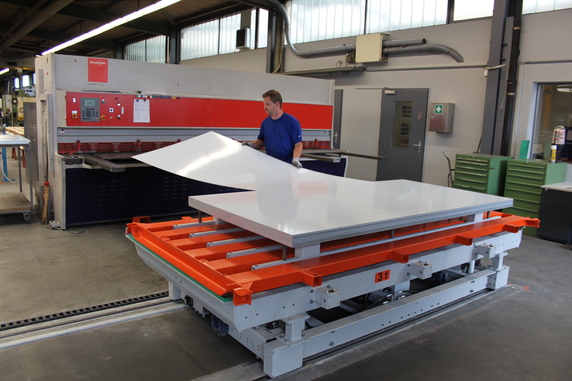
© Kasto
Using energy sparingly and intelligently
Energy consumption accounts for a large proportion of the operating costs of automated warehouses. However, Industry 4.0 also offers considerable optimization potential here: Kasto, for example, has developed an innovative concept for energy recovery and storage with Kastoenergysave. Excess positional or kinetic energy can thus be converted into electrical current, temporarily stored in double-layer capacitors and used flexibly as required. An intelligent control system charges and discharges the energy storage depending on the process currently running. The energy remains in the system until it is reused.
Due to an almost constant power draw from the power grid, the grid periphery can operate in nominal load mode. Users can thus additionally reduce the connected load of the storage and retrieval machine by more than 50 percent. The energy storage system also avoids peak loads, which saves further costs.
Reduce waste and increase service life
In addition to energy efficiency, material efficiency also plays an important role in metal processing – for example in sawing. Here, users are faced with the challenge of making the best possible use of the material used and avoiding waste in order to keep costs low. With its Kastooptisaw software, Kasto also uses the possibilities of digitization for this purpose: The system takes into account various machine parameters such as kerf width and minimum kerf length for an optimal assignment of the stored long material to the respective sawing orders. This is because operators often store bars, tubes and profiles of different lengths with different mitre angles due to past orders of one and the same material. Thanks to Kastooptisaw, these can be used with as little waste as possible – this reduces costs and saves space in the warehouse, as unusable remnants are no longer stored back.
Another smart innovation for sawing technology is Kastorespond: This system “senses” the nature of the material to be sawn by means of intelligent sensor technology and adjusts the cutting parameters accordingly. This offers significant advantages especially when sawing profiles, inhomogeneous materials or deviations in the strength of the workpiece. Users can thus optimize the service life and utilization of their tools in the long term. In addition, errors caused by incorrect operation of the sawing machine can be reliably avoided.
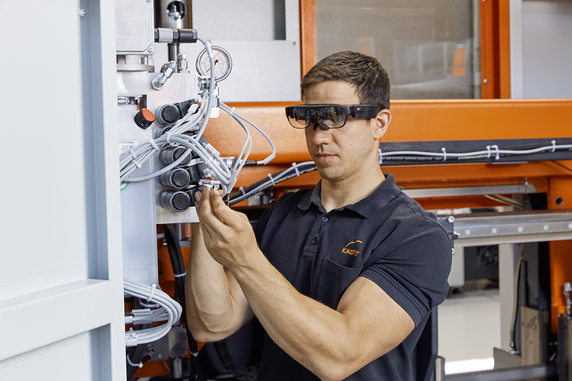
© Kasto
More efficient sawing with robot connection
With the robot connection Kastosort, Kasto also has a solution in its portfolio with which production processes upstream and downstream of the sawing process can be automated and integrated together into a uniformly controlled material flow. Industrial robots can independently remove the saw cuttings and perform numerous other tasks: from deburring and chamfering to centering and threading, marking and printing, weighing, sorting, pack density-optimized stacking and picking.
Kastosort impresses with its intelligence: the control system selects, for example, the appropriate gripper, the most suitable load carrier and the optimum stacking pattern depending on the material, shape, weight or other characteristics of the workpieces. Depending on the customer’s needs, Kasto integrates the robot control into the saw control, the WMS Kastologic or into an existing ERP system. The user can thus also control and monitor this work step via a central interface and benefits from an optimally coordinated process chain.
For the transport of materials and workpieces beyond storage and sawing technology, Kasto also offers digital and networked solutions. The company has, for example, developed the intelligent tour distribution system Kastorail, which efficiently and ergonomically prepares order picking bundles for dispatch. Another option for smart automation of manual pallet warehouses, for example, is the use of a driverless transport system (AGV). The autonomous vehicles can, for example, robotically pick up sections stacked on pallets from the saw’s work area and store them temporarily or transport them directly to shipping. The control of the AGV can also be integrated into Kastologic with its own interface in order to achieve a uniformly managed material flow. Roller shutter doors that open or close by activating photoelectric sensors allow floor trucks access to the sawing machine while protecting employees from injury.
Kastoapp: Machines in view at all times
The use of mobile devices is also becoming increasingly common in industrial production. Kasto has launched the Kastoapp, an application for the clear visualization of its sawing machines. It provides a status overview of all Kasto machines in the network that are equipped with the SmartControl, AdvancedControl, ProControl or ExpertControl control systems. The name and condition of each saw as well as the machine number and the machine type can be seen at a glance. If a saw is running in automatic mode, the Kastoapp can also access the information stored in the respective machine control. This provides the user with precise information on all relevant parameters such as article, cut-off length, target and actual number of pieces as well as feed and cutting speed. If an error occurs in the operating sequence, the app visualizes the pending error message and the user can react quickly. Downtimes can thus be reduced to a minimum.
VisualAssistance: Remote maintenance with augmented reality
Kasto goes one step further with its VisualAssistance assistance system, which uses the concept of augmented reality to simplify the remote maintenance of machines and systems. At its heart is an interactive app for tablets, smartphones or smart glasses. Customers can use it to connect with service staff via video and audio stream. Users and technicians share the same field of view in real time. This facilitates mutual understanding immensely and helps to quickly identify individual system components and possible faults.
The Kasto experts also have the option via the app to provide visual assistance and, for example, to fade in markers in the live video. While the customer is performing maintenance or repairs on the saw or bearing on site, all the necessary information is shown directly on his display. If he uses the data glasses, he also has his hands free – which makes the work even easier. The service technicians of Kasto are virtually on site and guide the employees accordingly. Time-consuming training courses or expensive journeys are therefore superfluous.
Intelligent solutions with practical customer benefits
In the future, Kasto intends to further expand its portfolio significantly in the direction of Industry 4.0. The acquisition and analysis of process data offers particularly great potential – for preventive maintenance measures, for example. With every new or further development, the focus is on the practical benefits for the user. And this is already immense: With Kasto’s Industry 4.0 solutions, metalworking companies can make their production significantly more flexible and efficient. Among other things, they benefit from ideal utilization of their machines, short non-productive times, lower maintenance requirements and lower production costs. Since the intelligent factory permanently monitors and optimizes itself, the quality of the manufactured parts is also consistently high, and operating errors are virtually eliminated. This in turn ensures satisfied customers and a good competitive position.
Web:
www.kasto.com


